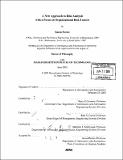| dc.contributor.advisor | Nancy G. Leveson. | en_US |
| dc.contributor.author | Marais, Karen, 1973- | en_US |
| dc.contributor.other | Massachusetts Institute of Technology. Dept. of Aeronautics and Astronautics. | en_US |
| dc.date.accessioned | 2006-03-29T18:47:07Z | |
| dc.date.available | 2006-03-29T18:47:07Z | |
| dc.date.copyright | 2005 | en_US |
| dc.date.issued | 2005 | en_US |
| dc.identifier.uri | http://hdl.handle.net/1721.1/32467 | |
| dc.description | Thesis (Ph. D.)--Massachusetts Institute of Technology, Dept. of Aeronautics and Astronautics, 2005. | en_US |
| dc.description | Includes bibliographical references (p. 235-255). | en_US |
| dc.description.abstract | Preventing accidents in complex socio-technical systems requires an approach to risk management that continuously monitors risk and identifies potential areas of concern before they lead to hazards, and constrains hazards before they lead to accidents. This research introduces the concept of continuous participative risk management, in which risks are continuously monitored throughout the lifetime of a system, and members from all levels of the organization are involved both in risk analysis and in risk mitigation. One aspect of effective risk management is accurate risk analysis that takes account of technical, human, and organizational factors. This research develops a new approach to risk analysis that improves on event-based models to include risks that do not depend only on component or subsystem failures, and incorporates both human and organizational factors. The approach enables the early identification of risk mitigation strategies, aids in the allocation of resources to best manage risk, and provides for the continuous monitoring of risk throughout the system lifecycle. Organizational factors have been identified as a significant aspect of accidents in complex socio-technical systems. Properly managing and assessing risk requires an understanding of the impact of organizational factors on risk. Three popular theories of organizational risk, normal accidents theory (NAT), high reliability organizations (HRO), and normalization of deviance, are reviewed. While these approaches do provide some useful insights, they all have significant limitations, particularly as a basis for assessing and managing risk. This research develops the understanding of organizational risk factors by focussing on the dynamics of organizational risk. | en_US |
| dc.description.abstract | (cont.) A framework is developed to analyze the strategic trade-offs between short and long-term goals and understand the reasons why organizations tend to migrate to states of increasing risk. The apparent conflict between performance and safety is shown to result from the different time horizons applying to performance and safety. Performance is measured in the short term, while safety is indirectly observed over the long term. Expanding the time horizon attenuates the apparent tension between performance and safety. By increasing awareness of the often implicit trade-offs between safety and performance, organizations can avoid decisions that unwittingly increase risk. In addition to this general dynamic, several specific common patterns of problematic organizational behaviour in accidents in diverse industries are identified. While accidents usually differ in the technical aspects, the organizational behaviour accompanying the accident exhibits commonalities across industries. These patterns of behaviour, or archetypes, can be used to better understand how risk arises and how problematic organizational behaviours might be addressed in diverse settings such as the space industry and chemical manufacturing. NASA specific archetypes are developed based on historical accounts of NASA and investigations into the Challenger and Columbia accidents. The NASA archetypes illustrate several mechanisms by which the manned space program migrated towards high risk. | en_US |
| dc.description.statementofresponsibility | by Karen Marais. | en_US |
| dc.format.extent | 372 p. | en_US |
| dc.format.extent | 21436344 bytes | |
| dc.format.extent | 21462086 bytes | |
| dc.format.mimetype | application/pdf | |
| dc.format.mimetype | application/pdf | |
| dc.language.iso | eng | en_US |
| dc.publisher | Massachusetts Institute of Technology | en_US |
| dc.rights | M.I.T. theses are protected by copyright. They may be viewed from this source for any purpose, but reproduction or distribution in any format is prohibited without written permission. See provided URL for inquiries about permission. | en_US |
| dc.rights.uri | http://dspace.mit.edu/handle/1721.1/7582 | |
| dc.subject | Aeronautics and Astronautics. | en_US |
| dc.title | A new approach to risk analysis with a focus on organizational risk factors | en_US |
| dc.type | Thesis | en_US |
| dc.description.degree | Ph.D. | en_US |
| dc.contributor.department | Massachusetts Institute of Technology. Department of Aeronautics and Astronautics | |
| dc.identifier.oclc | 61763171 | en_US |
